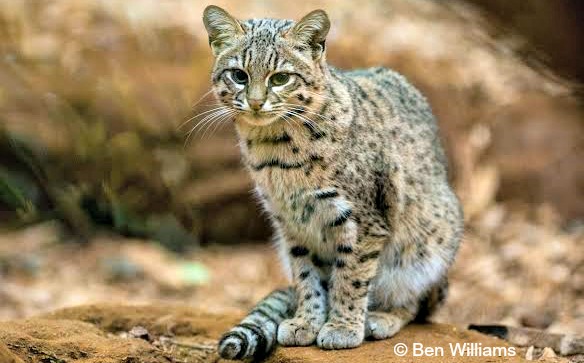The conservation status of the smaller 28 wild cat species varies widely. Earlier this month the IUCN revised their Red Data List, so an update to our Status of Wild Cats chart was in order. There were a few surprises.
Geoffroy’s Cat – This cat is widespread and abundant throughout its range, in all habitats. Its distribution range is continuous, meaning there are no isolated populations. Perhaps the most important factor in their new listing as Least Concern is the fact that these cats have adapted to the conversion of sub-tropical forest into croplands, and seem to be fairly tolerant of habitat alteration. Much like the Bobcat in North America, these cats appear to be adaptable to new situations, and their population is now considered Stable.
Iberian Lynx – This beautiful cat has actually been down-listed. Previously classed as Critically Endangered, they are now classed as Endangered, with an increasing population. Of the 37 wild cat species, this is the only one whose population is increasing, due to the enormous efforts of the people involved in their breeding and reintroduction. They are a perfect example of humans saving a species if the will and the effort is there.
Sand Cat – In 1996, these small cats were classed as Least Concern. In 2008, and again in 2015, they were classed as Near Threatened. In each of the classification years however, their population trend was and is listed as Unknown. In this day of camera traps and wildlife cameras, no one actually has any idea how many sand cats there are. Are they endangered? Are they common?
Sand Cats are native to Algeria; Egypt; Iran, Islamic Republic of; Israel; Jordan; Kazakhstan; Kuwait; Mauritania; Morocco; Niger; Oman; Pakistan; Saudi Arabia; Syrian Arab Republic; Turkmenistan; United Arab Emirates; Uzbekistan; Western Sahara; Yemen. The geopolitical situation in many of these countries explains the serious lack of field studies on these cats.
It is very difficult to find good news in the conservation world, so we’ll close with a list of the ten NON-endangered small wild cats:
- Bobcat – Least Concern, Population Stable
- Canada Lynx – Least Concern, Population Stable
- Eurasian Lynx – Least Concern, Population Stable
- Leopard Cat – Least Concern, Population Stable
- Serval – Least Concern, Population Stable
- Jaguarundi – Least Concern, Population Decreasing
- Jungle Cat – Least Concern, Population Decreasing
- Ocelot – Least Concern, Population Decreasing
- Wildcat – Least Concern, Population Decreasing
- Caracal – Least Concern, Population Unknown
You can read the complete wild cat list on our Status of Wild Cats page.
